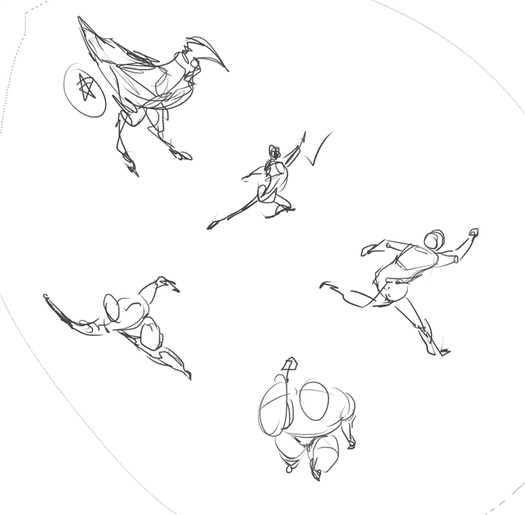Thank you for stopping by this blog post. I hope you enjoyed these small, simple things to draw – And that you may have fun trying them out for yourself!
THESE SIMPLE EXERCISES ARE AMONG THE BEST ONE CAN PRACTICE AS AN ARTIST.
Below, I’ll get into why, but first, let’s list these bad boys out:
- Straight lines
- Shape Spree
- Perspective Practice
- Gestural Thumbnails
- Compositional Thumbnails
Now, why are these my favorite drawing exercises for beginners?
Because it’s most of what you need packed into 5 exercises.
Here’s the rub – they’ve all got varying levels of difficulty too,
Have you ever watched a musician play a scale?
There are hundreds of ways to play just ONE of them.
Each time you consciously and deliberately play the scale, you’re building neural connections that will foster greater ability. When it becomes too easy (the point where you can do it without looking or thinking, hold a vigorous conversation, etc…) then it’s time to amplify the difficulty level.
So below, I’m going to show you how to do each of these exercises, and then I’ll give you variants for how to make them harder once you master the early forms.
Lastly, I’ll show you HOW they apply to drawing what you actually want to draw. No, I won’t just leave you with a set a wonderful exercises, I’ll give you the connection points between what you’re practicing, and how it applies.
1 – Loosing the lines

One of the biggest complaints I hear from beginners or would-be artists is “I can’t even draw a straight line!” Turns out, they require practice…Who knew? Drawing a straight line is crucial for man-made objects like vehicles and buildings, and drawing curved lines is crucial for more organic forms. Learning your lines isn’t just for acting, it’s for drawing too. Once you’re able to confidently and easily make marks of all sorts, your drawing toolkit grows to accommodate constructing everything from a cup to a full-blown person. Lines make it all happen.
Added difficulty: curved lines, shaded lines, longer lines.
2 – Shape Spree

This is one of my favorites. After you’ve got some straight-line confidence, you can begin blasting out shapes all over your digital documents and sketchbook pages. Basic shapes are the forms that all forms reduce down to. Cones, Cylinders, Spheres, Half-Spheres, Pyramids, Circles, Triangles, Ovals, Cubes, etc… All of these will help you build the basis for the more complex forms that you’ll be drawing thereafter.
Added difficulty: More complex geometry, shaded shapes.
3 – Perspective Practice

Perspective is integral. Really, it’s key. If you don’t learn perspective, your drawings will suffer. I promise. It hurts to spend hours on a drawing only to have deeply flaws perspective errors muddying the message of the work. That’s why we can do some simple drills to train our brains to work in accordance with this amazing fundamental.
Added difficulty: 2 point or 3 point perspective, all the way up to 4-point and fisheye perspectives.
4 – Gestural Thumbnails

Who doesn’t like sketching little poses all over the page? With this technique, you can learn to get a powerful overview of human and animals forms in a matter of seconds. Having a small reference point will allow you to configure things like pose and proportion, making it way easier to blow the drawing up to something more rad and readable.
Added difficulty: Harder poses, complex animals, one pose at every angle.
5 – Compositional Thumbnails

The granddaddy of ‘em all is composition. It’s how you arrange shapes, lines, forms, subjects, objects, and everything in between on a picture plane (like a piece of paper.)
Try doing them exclusively in black and white, or even color thumbnails. Try to do one scene at various angles.
Video Demo:
Conclusion:
If you’re practicing these exercises for at least 15-25 minutes per time, and racking up 2-3 of those sessions each day, you’ll notice a new ease begin to take shape in your workflow. There’s no feeling like adding levels of skill with each passing day. Before diving into your work, just be sure to do the relevant kind of practice. If you’re working on a line-heavy piece, do the line exercises— or if you’re working on a figure drawing, the gestural ones will serve you well.
All it takes is a few weeks of being consistent to gain more proficiency, and once you’re feeling that you could use a new challenge, step it up a notch. Effectively, your work outside of your practices (the pieces you want to create) will challenge you enough, but having some strong exercises to warm and level you up makes drawing even more fun.
P.S. – REMEMBER THE FUNDAMENTALS!
Whenever you’re ready, there are 2 ways I can help you:
1. Grow & Sharpen Your Drawing Skills here. (1,800+ students)
2. Build better Paintings and get Commissions here. (500+ students)
That’s all for now. Happy Drawing!
Moon


Mountain


Mug







